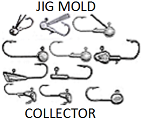but, when casting (and probably freefalling & trolling, too) the jig is on a "bent" line. By that, I mean that the line isn't exactly straight between the rod tip and jighead eye ... unless you're retrieving speed is pretty fast. When the jig hits the water, it starts to sink immediately, and your line (from the rod tip to the water's surface) is in an upside down arch. The line from the water's surface to the jighead eye, is in a rightside up arch. The line is kind of in the "tilda" shape (like this ~ ) ... looking at it as if the jig were on the left and rod tip were on the right of the tilda. This is the case when a very slow retrieve is being used. Most any jig will ride in the "natural" position, just from the dynamics of the retrieve speed/water resistance, under these slow retrieve conditions. The "tilda" shape in the line, is what allows the fish to take the bait ... causing the line to jump, but not necessarily allowing you to "feel" the thump. It's one of the main reasons I use hi-vis line ... so I can "see" ALL of the hits, whether I "feel" them or not.
In the "Freefall" or "Trolling" case ... the line is in the shape of a elongated, backwards J lying on its side. Or, in other words, the line from rod tip to water is fairly straight ... but the line, from water's surface to jig, is arched ... with the jig riding below the plane of the straight line, due to its weight constantly pulling down on the line, versus the water resistance against the line. This is all conditional to the jig's weight vs movement speed, too.
Jigheads with collars/barb are generally for use with plastic bodies, while collarless jigs are generally tied with feathers/artificial material. How the line is tied to the jighead eye, can also play a role ... especially in vertical jigging manuvers. But, even there, one has to understand that a minnow doesn't rise/fall in the water column, while maintaining a perfectly horizontal (natural) position. When they come up, they're head up/tail down .. and when they dive down, they're head down/tail up. Even though they "can" sink/rise while still staying in the horizontal position, by using their swim bladder, they don't seem to do so, very often.
These are just my observations, limited as they are, and I could be over/under simplifying things.
We should get a good discussion going on this one :p
... cp


 Likes:
Likes:  Thanks:
Thanks:  HaHa:
HaHa: 


 Reply With Quote
Reply With Quote


















